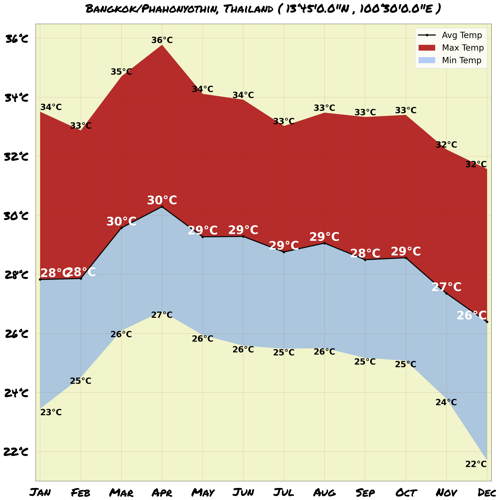Understand
Phahonyothin Road, originally known as Prachathipatai Road, stretches for 22 kilometers from Victory Monument to Don Muang Airport in Bangkok, Thailand. This road has a rich history, with Field Marshal Plaek Phibunsonhkhram extending it all the way to Sing Buri and renaming it Phahonyothin Road in honor of General Phraya Pholphayuhasena, the second Prime Minister of Thailand, also known as Phot Phahonyothin. Over time, it was further extended to the Burmese border, covering an impressive length of 1,005 kilometers. Within the Bangkok Metropolitan Administration, Phahonyothin is a vast district encompassing 30 kilometers from north to south. Don Muang Airport has played a significant role in the development of Phahonyothin Road. Serving as an important airline hub, it was once the second busiest airport in Asia by passenger volume. Commercial flights began operating here in 1924, leading to the establishment of numerous hotels and businesses in the district. This vibrant commercial activity contributed to the expansion of Bangkok towards the north, turning Phahonyothin into one of the most developed suburbs. Today, many Bangkok residents call this area home, commuting to downtown every day. However, traveling from the outskirts to the southern part of Phahonyothin can take upwards of two hours due to heavy traffic. While the northern part of Phahonyothin Road is relatively unexplored by foreign visitors, the southern section offers exciting attractions. Shopping takes center stage in this area, particularly the renowned Chatuchak Weekend Market, which boasts over 8,000 stalls and holds the title of Southeast Asia's largest market. Additionally, Soi Ari has transformed into a trendy, artistic neighborhood with a variety of affordable and upscale dining options. While foreigners may not be familiar with Soi Ari yet, it is a hidden gem waiting to be discovered. Following the opening of Suvarnabhumi Airport, Don Muang Airport experienced a temporary closure. After undergoing extensive renovations, it reopened exclusively for non-connecting domestic flights, though few airlines currently utilize it. This shift in air traffic had a significant impact on the local economy, causing five-star hotels in the area to downgrade to two-star accommodations and prompting airport-related businesses to relocate from the far north. Fortunately, 30 kilometers south of Don Muang, commercial activity and popularity endure.
Map & Climate
Popular Foods
 Pad Thai: Pad Thai is a signature Thai dish consisting of stir-fried rice noodles with a uniquely balanced blend of sweet, sour, salty, and tangy flavors. It typically includes shrimp or chicken (though can be prepared with tofu for a vegetarian version), scrambled eggs, bean sprouts, and is garnished with crushed peanuts, lime wedges, and fresh herbs like cilantro and green onions. The dish is served with a side of som tam (green papaya salad) and mango sticky rice for a complete meal.
Pad Thai: Pad Thai is a signature Thai dish consisting of stir-fried rice noodles with a uniquely balanced blend of sweet, sour, salty, and tangy flavors. It typically includes shrimp or chicken (though can be prepared with tofu for a vegetarian version), scrambled eggs, bean sprouts, and is garnished with crushed peanuts, lime wedges, and fresh herbs like cilantro and green onions. The dish is served with a side of som tam (green papaya salad) and mango sticky rice for a complete meal.  Tom Yum Goong: This spicy and aromatic soup is a beloved Thai classic that features a fragrant broth made from stock, kaffir lime leaves, lemongrass, galangal, lime juice, fish sauce, and chili paste. It's packed with succulent prawns, mushrooms, tomatoes, and other vegetables, with optional additions like snakehead fish or even chicken. The dish is often garnished with fresh cilantro and a sprinkling of pepper.
Tom Yum Goong: This spicy and aromatic soup is a beloved Thai classic that features a fragrant broth made from stock, kaffir lime leaves, lemongrass, galangal, lime juice, fish sauce, and chili paste. It's packed with succulent prawns, mushrooms, tomatoes, and other vegetables, with optional additions like snakehead fish or even chicken. The dish is often garnished with fresh cilantro and a sprinkling of pepper.  Mango Sticky Rice: This iconic Thai dessert is a delightful combination of sweet, creamy mango and glutinous rice. The sticky rice is cooked in coconut milk and sugar until it achieves a chewy texture, then served alongside ripe, juicy mango slices. The dish is sometimes garnished with toasted coconut flakes or sesame seeds for added crunch and flavor. It's typically enjoyed during the mango season (May to September) as a sumptuous, refreshing treat.
Mango Sticky Rice: This iconic Thai dessert is a delightful combination of sweet, creamy mango and glutinous rice. The sticky rice is cooked in coconut milk and sugar until it achieves a chewy texture, then served alongside ripe, juicy mango slices. The dish is sometimes garnished with toasted coconut flakes or sesame seeds for added crunch and flavor. It's typically enjoyed during the mango season (May to September) as a sumptuous, refreshing treat. 




Comments
NO COMMENTS